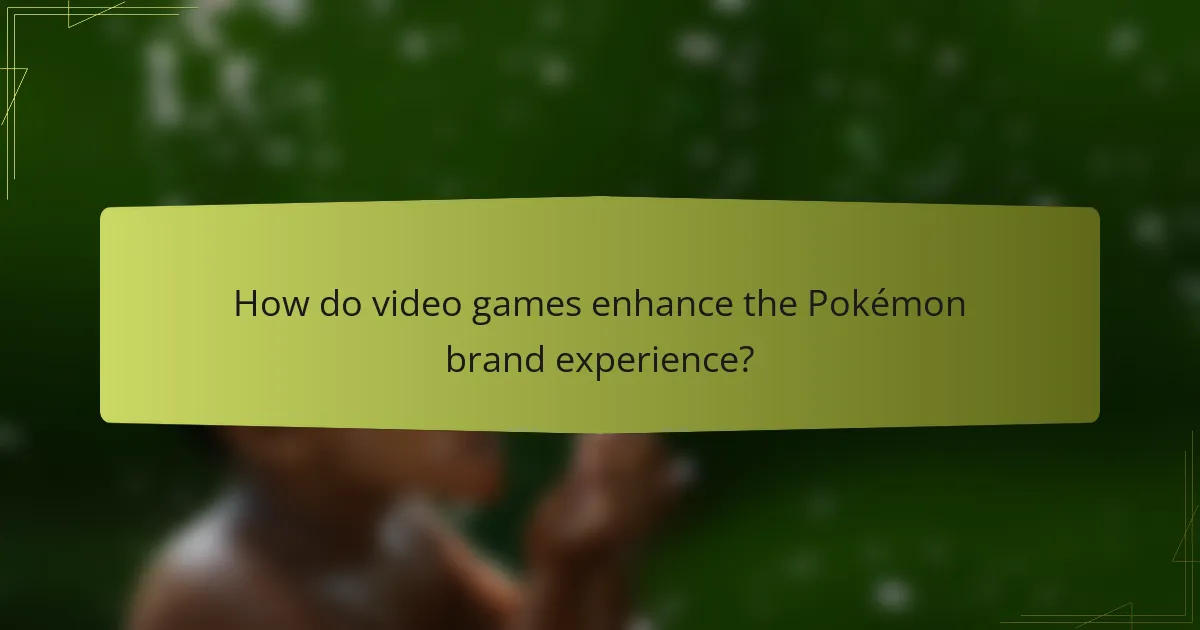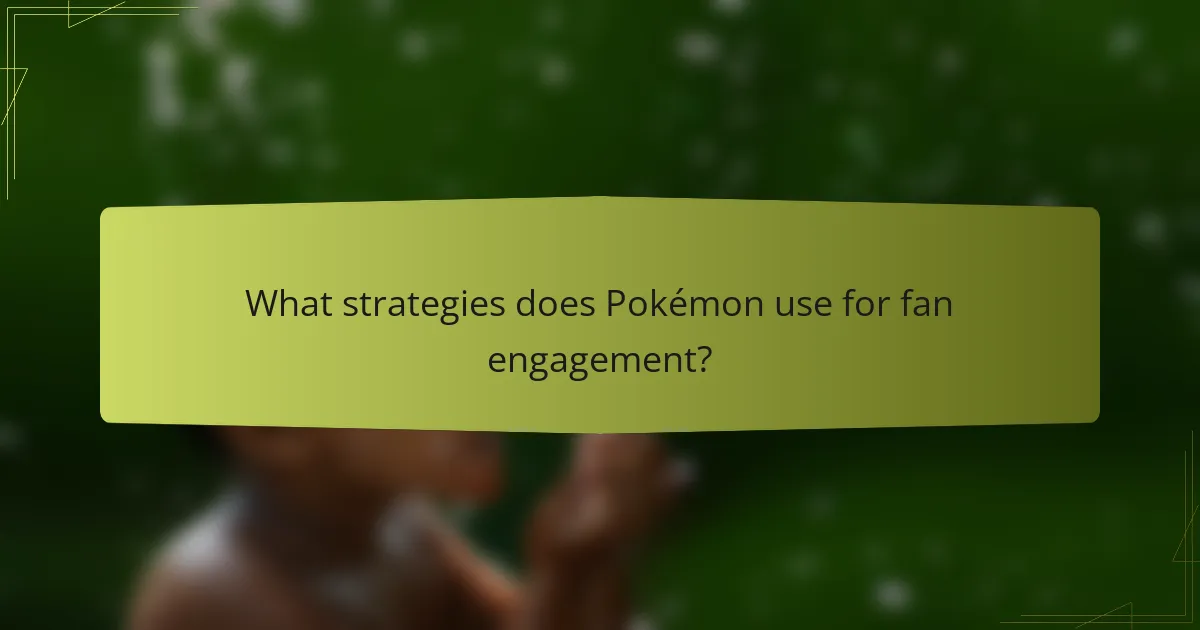The Pokémon brand encompasses a diverse range of products, including video games, trading card games, merchandise, and animated series, contributing to its widespread appeal across various demographics. Engaging gameplay fosters exploration and strategy, while community events and interactive platforms, such as Pokémon Go, enhance social connections among fans. Nostalgia plays a crucial role in brand loyalty, as many individuals have grown up with the franchise. The article examines the strategies employed by Pokémon for fan engagement, including mobile apps, social media interaction, and regular events, all of which cultivate a vibrant and lasting community around the brand.

What factors contribute to the success of the Pokémon brand?
The success of the Pokémon brand is driven by its diverse product offerings, engaging gameplay, and strong community. The franchise includes video games, trading card games, merchandise, and animated series. This variety appeals to different demographics, enhancing its reach. Pokémon’s gameplay encourages exploration and strategy, making it enjoyable for players of all ages. The brand also fosters a sense of community through events and online platforms. Pokémon Go, for example, brought millions together in real-world gameplay. Additionally, nostalgia plays a significant role, as many fans grew up with the franchise. These factors combined create a strong, lasting brand presence in popular culture.
How did Pokémon evolve from a video game to a global phenomenon?
Pokémon evolved from a video game to a global phenomenon through strategic marketing, diverse media expansion, and community engagement. The original Pokémon video game was released in 1996 by Game Freak and Nintendo. Its unique gameplay and trading mechanic attracted a dedicated fan base. The franchise expanded into an animated television series in 1997, increasing its visibility. Merchandise, including trading cards and toys, further solidified its presence in popular culture. Pokémon Go, launched in 2016, revitalized interest through augmented reality. Major events like Pokémon World Championships fostered community involvement. The franchise has generated over $100 billion in revenue, showcasing its massive global impact.
What were the initial concepts behind Pokémon’s creation?
The initial concepts behind Pokémon’s creation were inspired by Satoshi Tajiri’s childhood interest in collecting creatures and his love for nature. Tajiri envisioned a game where players could capture and train various creatures. This concept was influenced by his experiences of collecting insects as a child. The idea was to create a sense of adventure and exploration. The gameplay was designed to encourage social interaction through trading and battling. The original games were released in Japan in 1996. They quickly gained popularity, leading to a franchise that expanded into various media. Pokémon’s success is rooted in its innovative gameplay and strong community engagement.
How has the brand’s evolution influenced its current status?
The evolution of the Pokémon brand has significantly influenced its current status as a leading entertainment franchise. Initially launched in 1996 as a video game, Pokémon quickly expanded into trading cards, animated series, and merchandise. This diversification allowed the brand to reach a wider audience and maintain relevance over decades.
The introduction of mobile games, particularly Pokémon GO in 2016, revitalized interest among both new and returning fans. This game alone generated over $1 billion in revenue within its first year, showcasing the brand’s ability to innovate and adapt to changing consumer behaviors.
Additionally, the brand’s consistent engagement with its community through events and competitions has fostered a loyal fan base. Pokémon’s presence at major conventions and its active social media strategy have kept the brand in the public eye.
Overall, the Pokémon brand’s evolution from video games to a multifaceted entertainment empire has solidified its status as a cultural phenomenon.
What role do collectibles play in Pokémon’s brand success?
Collectibles are a crucial component of Pokémon’s brand success. They enhance engagement by providing fans with tangible items to connect with the franchise. Pokémon cards, toys, and other collectibles create a sense of nostalgia and community among fans. The trading card game alone has generated billions in revenue since its launch in 1996. Collectibles also drive repeat purchases, as fans seek to complete their collections. Limited edition items create urgency and exclusivity, further boosting sales. Pokémon’s collectibles are integral to its identity, reinforcing brand loyalty and expanding its market reach.
How do Pokémon cards and merchandise impact fan engagement?
Pokémon cards and merchandise significantly enhance fan engagement. These collectibles create a tangible connection between fans and the Pokémon universe. The act of collecting cards fosters community interaction. Fans often trade and showcase their collections at events. This interaction strengthens social bonds among fans. Merchandise, such as toys and apparel, extends the brand experience. It allows fans to express their affinity for Pokémon in daily life. Additionally, limited edition releases generate excitement and urgency. This drives fans to participate actively in the Pokémon community. Overall, cards and merchandise serve as vital tools for maintaining fan interest and loyalty.
What are the most sought-after Pokémon collectibles?
The most sought-after Pokémon collectibles include first edition holographic cards and rare promotional items. First edition holographic Charizard cards are particularly valuable, often selling for thousands of dollars. Other highly desired cards include Pikachu Illustrator cards, which are extremely rare and prized by collectors. Additionally, sealed booster boxes from early sets attract significant interest. Vintage toys and action figures from the 1990s also hold considerable value among fans. Collectors often seek complete sets of cards from specific expansions, especially those featuring fan-favorite Pokémon. The rarity and condition of these items greatly influence their market value.

How do video games enhance the Pokémon brand experience?
Video games enhance the Pokémon brand experience by immersing players in interactive worlds. These games allow players to explore various regions, catch Pokémon, and engage in battles. Such gameplay fosters a deeper connection to the franchise. Players can form emotional attachments to their Pokémon, enhancing brand loyalty. The release of titles like Pokémon Go has significantly increased engagement. Pokémon Go, for instance, has over 400 million downloads, showcasing its popularity. Events and community days in the game encourage social interaction among players. This interaction strengthens the community surrounding the brand. Video games also integrate with other media, creating a cohesive brand experience.
What are the key video games in the Pokémon franchise?
The key video games in the Pokémon franchise include Pokémon Red and Blue, Pokémon Gold and Silver, Pokémon Ruby and Sapphire, Pokémon Diamond and Pearl, Pokémon Black and White, Pokémon X and Y, Pokémon Sun and Moon, and Pokémon Sword and Shield. Pokémon Red and Blue were released in 1996 and established the franchise. Pokémon Gold and Silver introduced the second generation in 1999. Pokémon Ruby and Sapphire, released in 2002, brought new gameplay mechanics. Pokémon Diamond and Pearl, launched in 2006, introduced online trading and battling. Pokémon Black and White, released in 2010, featured a new storyline and Pokémon. Pokémon X and Y, which came out in 2013, were the first in 3D graphics. Pokémon Sun and Moon, released in 2016, added regional variants. Pokémon Sword and Shield, launched in 2019, introduced the Galar region and Dynamax feature. Each game has contributed significantly to the franchise’s development and popularity.
How do different Pokémon games cater to various audiences?
Different Pokémon games cater to various audiences by offering diverse gameplay experiences. Main series games focus on exploration and battling, appealing to traditional RPG fans. Spin-off titles, like Pokémon GO, attract casual players with augmented reality and social interaction. Pokémon Mystery Dungeon engages players who enjoy roguelike mechanics and storytelling. Pokémon trading card games target strategy enthusiasts through deck-building and competitive play. Each game’s design reflects the preferences of its intended audience, ensuring broad appeal. For instance, Pokémon GO reached over 400 million downloads, showcasing its success with casual gamers.
What innovations in gameplay have kept Pokémon relevant?
Innovations in gameplay that have kept Pokémon relevant include the introduction of Mega Evolutions and Dynamaxing. Mega Evolutions, introduced in Pokémon X and Y, allowed certain Pokémon to temporarily evolve during battles, enhancing strategy and excitement. Dynamaxing, featured in Pokémon Sword and Shield, enabled Pokémon to grow in size and power, adding a new layer to battles.
The incorporation of open-world elements in Pokémon Legends: Arceus transformed the gameplay experience. Players could explore vast environments freely, marking a departure from traditional linear gameplay. Online features, such as Pokémon GO’s real-world integration, brought the franchise into augmented reality, engaging a broader audience.
Regular updates and expansions, like the DLC for Pokémon Sword and Shield, have kept the gameplay fresh and appealing. These innovations have continually attracted both new and returning players, ensuring Pokémon’s enduring popularity in the gaming landscape.
How does gameplay influence player loyalty and brand attachment?
Gameplay significantly influences player loyalty and brand attachment by creating immersive experiences. Engaging gameplay fosters emotional connections with characters and narratives. This emotional engagement leads to increased player retention. Players are more likely to return to games that provide enjoyable and rewarding experiences. For example, Pokémon games utilize captivating mechanics and collectible elements. These features enhance the overall gaming experience, encouraging players to invest time and resources. Research shows that emotional investment in gameplay correlates with brand loyalty. A study by Hamari and Koivisto (2015) found that user engagement directly impacts loyalty in gaming communities. Thus, effective gameplay design is crucial for building lasting player relationships with brands.
What features enhance the gaming experience for players?
Interactive gameplay enhances the gaming experience for players. This includes features like multiplayer options, which allow players to connect and compete with others. Engaging storylines immerse players in the game world. High-quality graphics and sound design enhance visual and auditory experiences. Customization options enable players to personalize their characters or gameplay. Regular updates and events keep the game fresh and engaging. Community features foster social interaction among players. These elements collectively contribute to a more enjoyable and immersive gaming experience.
How do community events and competitions foster engagement?
Community events and competitions foster engagement by creating opportunities for social interaction among participants. These events encourage collaboration and friendly competition, enhancing the sense of belonging. For example, Pokémon tournaments bring fans together, allowing them to share strategies and experiences. Research shows that social gatherings can increase community ties and loyalty to brands. A study by the Journal of Marketing found that community events significantly boost customer engagement and brand attachment. Engaged participants are more likely to advocate for the brand, leading to increased visibility and growth.

What strategies does Pokémon use for fan engagement?
Pokémon employs several strategies for fan engagement. These include interactive mobile apps like Pokémon GO, which encourage outdoor activity and community events. The franchise also utilizes social media platforms to connect with fans through updates and user-generated content. Regular events, such as Pokémon tournaments and special in-game challenges, foster competitive spirit and community involvement. Merchandise, including trading cards and toys, keeps fans invested in the brand. Collaborations with other franchises, such as Pokémon’s appearances in Super Smash Bros., expand its reach. Seasonal events and themed promotions also maintain excitement among fans. Overall, these strategies create a vibrant community around the Pokémon brand.
How does Pokémon utilize social media to connect with fans?
Pokémon utilizes social media to connect with fans by creating engaging content and fostering community interaction. They share updates about games, events, and merchandise on platforms like Twitter, Instagram, and Facebook. This approach keeps fans informed and excited about new releases. Pokémon also encourages user-generated content through hashtags and challenges. This strategy enhances fan participation and creates a sense of belonging. Additionally, they host live events and Q&A sessions to interact directly with their audience. These tactics have successfully built a loyal fan base and increased brand engagement.
What platforms are most effective for Pokémon’s fan interaction?
The most effective platforms for Pokémon’s fan interaction are social media, forums, and gaming apps. Social media platforms like Twitter and Instagram facilitate real-time engagement and community building. Forums such as Reddit allow fans to share strategies and discuss game-related content. Gaming apps, including Pokémon GO, provide immersive experiences that encourage player interaction. According to a survey by Statista, 60% of Pokémon fans engage with the brand through social media. This data highlights the importance of these platforms in fostering fan interaction.
How does Pokémon create content that resonates with its audience?
Pokémon creates content that resonates with its audience by leveraging nostalgia, community engagement, and diverse media formats. The franchise taps into nostalgic elements by recalling memories of early games and shows. This connection fosters loyalty among long-time fans. Pokémon also emphasizes community through events like Pokémon GO Fest and trading card tournaments. These gatherings enhance social interaction and shared experiences. Additionally, Pokémon utilizes various media formats, including video games, animated series, and movies. This multi-platform approach allows for broad audience reach. According to a 2021 report, Pokémon became the highest-grossing media franchise, highlighting its widespread appeal and engagement.
What are the best practices for engaging with the Pokémon community?
Engaging with the Pokémon community requires active participation and respect for its culture. First, join online forums and social media groups dedicated to Pokémon. These platforms often host discussions about games, trading, and events. Second, attend local Pokémon events or tournaments to meet other fans in person. Building relationships in these settings fosters community spirit. Third, share your own Pokémon experiences and creations, such as fan art or strategies. This encourages interaction and feedback. Fourth, respect differing opinions and preferences within the community. Acknowledging diverse perspectives enhances mutual respect. Lastly, stay updated on Pokémon news and releases. Knowledge of current events shows commitment to the community. Engaging in these practices leads to a more fulfilling experience within the Pokémon community.
How can fans participate in Pokémon events and activities?
Fans can participate in Pokémon events and activities by attending official tournaments and community meetups. These events often include competitions where players can battle each other using their Pokémon teams. Fans can also join Pokémon-themed festivals that celebrate the franchise through various activities. Online events, such as virtual tournaments and trading events, allow fans to engage from anywhere. Additionally, fans can participate in Pokémon Go community days, which encourage players to explore their local areas. Social media platforms often promote events and provide updates on participation opportunities. Pokémon’s official website lists upcoming events and registration details. Engaging with local Pokémon communities can also enhance participation.
What tips can enhance fan involvement in the Pokémon universe?
Engaging fans in the Pokémon universe can be enhanced through various strategies. Organizing community events, such as Pokémon Go meetups, fosters social interaction. Creating online forums for discussions encourages fans to share experiences. Developing interactive content, like quizzes or fan art competitions, boosts participation. Offering exclusive in-game items for community challenges increases motivation. Collaborating with influencers can expand reach and attract new fans. Regularly updating game features keeps the content fresh and engaging. Lastly, involving fans in decision-making through surveys can strengthen their connection to the brand.
The main entity of the article is the Pokémon brand, which has achieved remarkable success through its diverse product offerings, including video games, trading cards, merchandise, and animated series. The article explores the factors contributing to this success, such as engaging gameplay, community involvement, and nostalgia. It details the evolution of Pokémon from a video game to a global phenomenon, the significance of collectibles in enhancing fan engagement, and the impact of various video games on brand loyalty. Additionally, strategies for fan interaction and participation in community events are highlighted, showcasing how Pokémon maintains its relevance and connection with its audience.
